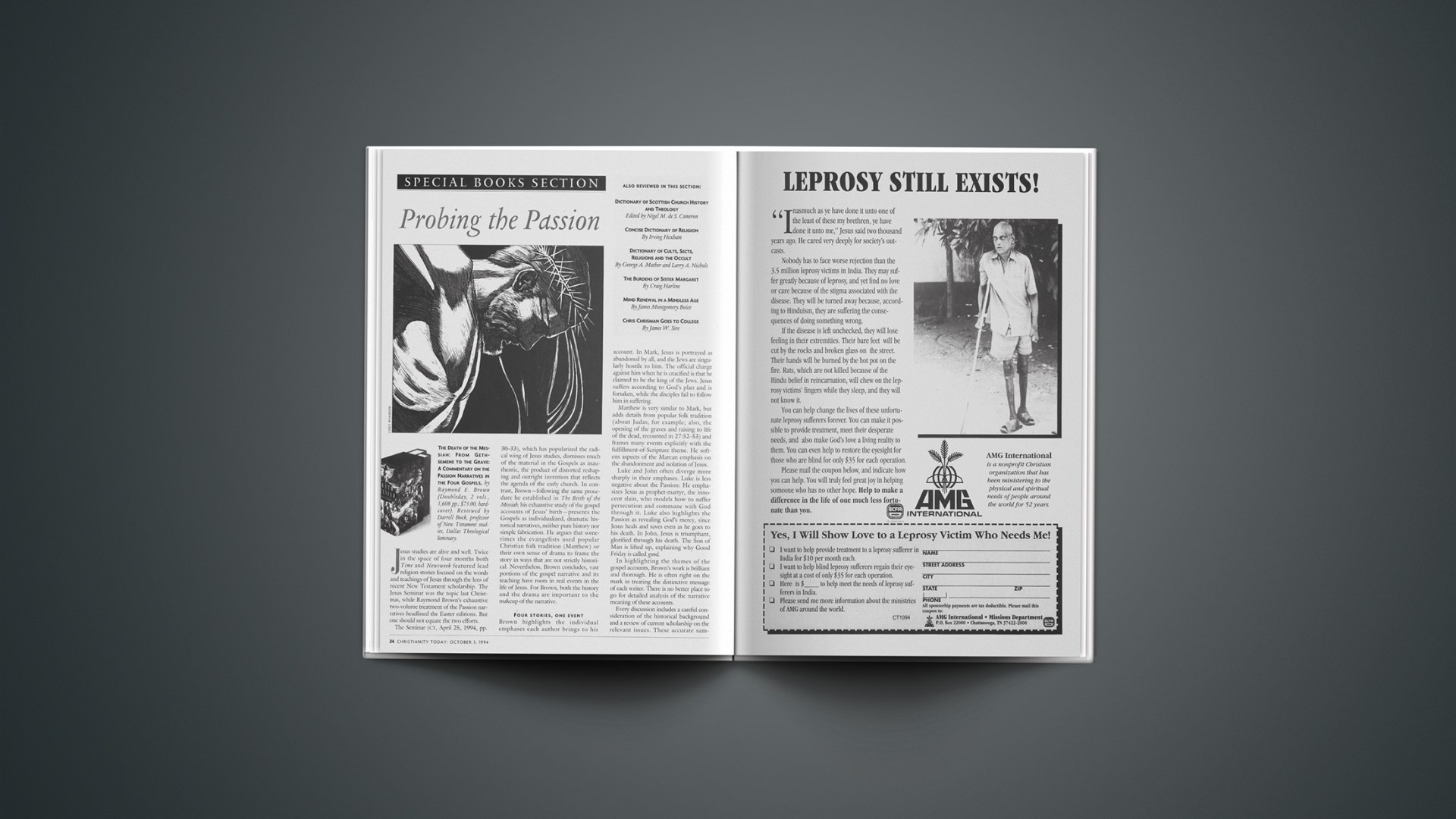“The Death Of The Messiah: From Gethsemene To The Grave: A Commentary On The Passion Narratives In The Four Gospels,” by Raymond E. Brown (Doubleday, 2 vols., 1,608 pp.; $75.00, hardcover). Reviewed by Darrell Bock, professor of New Testament studies, Dallas Theological Seminary.
Jesus studies are alive and well. Twice in the space of four months both Time and Newsweek featured lead religion stories focused on the words and teachings of Jesus through the lens of recent New Testament scholarship. The Jesus Seminar was the topic last Christmas, while Raymond Brown’s exhaustive two-volume treatment of the Passion narratives headlined the Easter editions. But one should not equate the two efforts.
The Seminar (CT, April 25, 1994, pp. 30-33), which has popularized the radical wing of Jesus studies, dismisses much of the material in the Gospels as inauthentic, the product of distorted reshaping and outright invention that reflects the agenda of the early church. In contrast, Brown—following the same procedure he established in “The Birth of the Messiah,” his exhaustive study of the gospel accounts of Jesus birth—presents the Gospels as individualized, dramatic historical narratives, neither pure history nor simple fabrication. He argues that sometimes the evangelists used popular Christian folk tradition (Matthew) or their own sense of drama to frame the story in ways that are not strictly historical. Nevertheless, Brown concludes, vast portions of the gospel narrative and its teaching have roots in real events in the life of Jesus. For Brown, both the history and the drama are important to the makeup of the narrative.
FOUR STORIES, ONE EVENT
Brown highlights the individual emphases each author brings to his account. In Mark, Jesus is portrayed as abandoned by all, and the Jews are singularly hostile to him. The official charge against him when he is crucified is that he claimed to be the king of the Jews. Jesus suffers according to God’s plan and is forsaken, while the disciples fail to follow him in suffering.
Matthew is very similar to Mark, but adds details from popular folk tradition (about Judas, for example; also, the opening of the graves and raising to life of the dead, recounted in 27:52-53) and frames many events explicitly with the fulfillment-of-Scripture theme. He softens aspects of the Marcan emphasis on the abandonment and isolation of Jesus.
Luke and John often diverge more sharply in their emphases. Luke is less negative about the Passion: He emphasizes Jesus as prophet-martyr, the innocent slain, who models how to suffer persecution and commune with God through it. Luke also highlights the Passion as revealing God’s mercy, since Jesus heals and saves even as he goes to his death. In John, Jesus is triumphant, glorified through his death. The Son of Man is lifted up, explaining why Good Friday is called good.
In highlighting the themes of the gospel accounts, Brown’s work is brilliant and thorough. He is often right on the mark in treating the distinctive message of each writer. There is no better place to go for detailed analysis of the narrative meaning of these accounts.
Every discussion includes a careful consideration of the historical background and a review of current scholarship on the relevant issues. These accurate summaries, which will be helpful to a wide range of readers, constitute another major strength of the work, especially since the analyses are supported by solid bibliographic information. However, Brown’s hesitation to appeal to later Jewish Mishnaic material, a caution popular in New Testament studies today, may be excessive in dealing with what was, after all, a conservative religious tradition, where change would have entered into community practice slowly.
NARRATIVE STRANDS
Brown devotes a good deal of attention to sources and historicity. He notes before he starts that the Passion narratives may well have more history in them than can be decisively proved by current methods. Brown himself relies most heavily on multiple attestation, a criterion that argues a tradition is likely to be historical the more widely attested it is in the various source strands that stand behind the Gospels (Mark, Q, M, L). Generally, Brown hunts for the multiple attested core in a passage and then correlates other details around this center. This is a solid approach as a starting point.
Copyright © 1994 Christianity Today. Click for reprint information.










